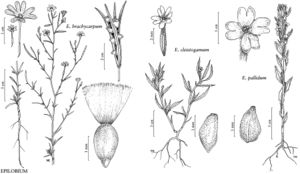Difference between revisions of "Epilobium cleistogamum"
Phytologia 73: 458. 1993.
imported>Volume Importer |
imported>Volume Importer |
||
| Line 20: | Line 20: | ||
|rank=species | |rank=species | ||
}} | }} | ||
| − | |hierarchy=Onagraceae;Onagraceae subfam. Onagroideae;Epilobium;Epilobium sect. Epilobiopsis;Epilobium cleistogamum | + | |hierarchy=Onagraceae;Onagraceae subfam. Onagroideae;Onagraceae tribe Epilobieae;Epilobium;Epilobium sect. Epilobiopsis;Epilobium cleistogamum |
| − | |hierarchy_nav=<div class="higher-taxa"><div class="higher-taxon"><small>family</small>[[Onagraceae]]</div><div class="higher-taxon"><small>subfamily</small>[[Onagraceae subfam. Onagroideae]]</div><div class="higher-taxon"><small>genus</small>[[Epilobium]]</div><div class="higher-taxon"><small>section</small>[[Epilobium sect. Epilobiopsis]]</div><div class="higher-taxon"><small>species</small>[[Epilobium cleistogamum]]</div></div> | + | |hierarchy_nav=<div class="higher-taxa"><div class="higher-taxon"><small>family</small>[[Onagraceae]]</div><div class="higher-taxon"><small>subfamily</small>[[Onagraceae subfam. Onagroideae]]</div><div class="higher-taxon"><small>tribe</small>[[Onagraceae tribe Epilobieae]]</div><div class="higher-taxon"><small>genus</small>[[Epilobium]]</div><div class="higher-taxon"><small>section</small>[[Epilobium sect. Epilobiopsis]]</div><div class="higher-taxon"><small>species</small>[[Epilobium cleistogamum]]</div></div> |
|volume=Volume 10 | |volume=Volume 10 | ||
|mention_page= | |mention_page= | ||
| Line 57: | Line 57: | ||
|publication year=1993 | |publication year=1993 | ||
|special status= | |special status= | ||
| − | |source xml=https://xjsachs2@bitbucket.org/aafc-mbb/fna-data-curation.git/src/ | + | |source xml=https://xjsachs2@bitbucket.org/aafc-mbb/fna-data-curation.git/src/e39f0e846f172941159b2045254d62d10d9823f6/coarse_grained_fna_xml/V10/V10_294.xml |
|subfamily=Onagraceae subfam. Onagroideae | |subfamily=Onagraceae subfam. Onagroideae | ||
| + | |tribe=Onagraceae tribe Epilobieae | ||
|genus=Epilobium | |genus=Epilobium | ||
|section=Epilobium sect. Epilobiopsis | |section=Epilobium sect. Epilobiopsis | ||
Latest revision as of 10:31, 9 May 2022
Herbs from slender taproot. Stems terete, 1.5–32 cm, simple or often with sprawling, stout, prostrate proximal branches, proximally glabrous, often distally spreading-hairy and ± glandular puberulent. Leaves subsessile, blade grayish green, linear to narrowly elliptic, proximally broader and surfaces subglabrous, distally narrower and surfaces densely villous, especially on margins and midrib, often folded along midrib, usually early-withering, 1.5–5.5 × 0.2–0.6 cm, base cuneate, margins serrulate, 5–18 low teeth per side, lateral veins obscure, 1–4 per side, apex acute; bracts scarcely reduced. Inflorescences erect spikes, leafy, densely villous and glandular puberulent, first flowers at most proximal nodes. Flowers ± cleistogamous, suberect, often hidden by subtending bracts; buds 2–4 × 1–1.5 mm, apiculate; floral tube 0.5–1 × 0.4–1 mm, raised ring of lax hairs near mouth inside; sepals pale green or reddish green, not keeled, 1.5–3 × 0.6–1.2 mm, apex acute, abaxial surface villous and glandular puberulent; petals white to pale pink, 2–5.8 × 0.8–1.8 mm, apical notch 0.5–1.5 mm; filaments light pink, those of longer stamens 0.6–1.6 mm, those of shorter ones 0.5–0.8 mm; anthers light yellow, 0.4–0.5 × 0.3–0.5 mm; ovary 8–11 mm, densely villous and glandular puberulent; style light pink, 1.4–2.4 mm, stigma capitate, ± 4-lobed to subentire, 0.5–0.9 × 0.4–0.8 mm, surrounded by longer anthers. Capsules narrowly cylindrical, often curved-ascending, sharply 4-angled with 4 strong ribs, 8–12 mm, beak 1.5–3 mm, tardily dehiscent on distal 1/3, central axis disintegrating, sparsely villous and glandular puberulent; sessile. Seeds 10–14 per tightly packed row, irregularly angular to fusiform, 1.2–1.5 ×0.4–0.6 mm, chalazal collar absent, surface irregularly reticulate. 2n = 30.
Phenology: Flowering May–Jul.
Habitat: Primarily around vernal pools, clay flats, other seasonally moist habitats, usually in heavy clay soil.
Elevation: 20–300(–1600) m.
Discussion
Epilobium cleistogamum is an annual species endemic to heavy clay soil in the Central Valley of California and surrounding foothills, from southern Tehama County to northern Tulare County and into the Sacramento River delta in Contra Costa and Solano counties, and barely to San Luis Obispo County in the southern Coast Range. Flowering often commences at the first or second proximal node, and flowers are frequently cleistogamous. The seeds are arranged nearly horizontally and are irregularly angular due to tight packing in the rigid capsules. Plants characteristically have decumbent branches and tardily dehiscent capsules that shed their seeds only following rains, often many months after fruits matured and plants were green (P. H. Raven 1969).
Selected References
None.
